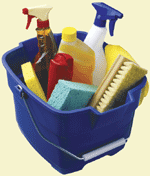Insights by Goldie: “Spring cleaning” takes new meaning
by Goldie Caughlan
This article was originally published in May 2005
If you or someone you love is spring cleaning, consider that the products you use for cleaning, cooking and storage can make a difference to your health.
PCC has a wide selection of cleaning and personal care products well-researched for efficacy and product safety. The quality of ingredients, too, compared to others widely advertised and sold is like … well, a breath of fresh air.
There’s a new report, “Sick of Dust; Chemicals in Common Products — a Needless Health Risk in Our Home,” that I hope you’ll read and share with everyone you know. It’s available at www.safer-products.org and is a much broader study than space permits me to review here.
The report calls for adoption of what’s being called Green Chemistry Principles, including the Precautionary Principle, requiring that safety be persuasively demonstrated through rigorous health and safety research and testing before a substance or technology is released to the marketplace. Unfortunately, this concept is not supported widely in the United States — yet. I hope this important study will help prevent the truth about toxins from continuing to be swept under the regulatory rug.
For the first time, household dust was studied from 70 homes in seven states, looking for six classes of chemicals (see list below) found to be toxic and harmful to the immune and reproductive systems of infants and young children especially, but also to the elderly and most animals.
Most chemicals found in this study have been detected in breast milk, blood and/or urine in other human studies, too. These substances generally didn’t exist less than a generation ago, yet now are mass-produced and used extensively in agriculture, electronic products, vinyl flooring, cosmetics, upholstery, medical and pharmaceutical products, and other everyday products. The report documents that governmental regulations are wholly inadequate to the task of monitoring or requiring safety testing of the tons of chemicals in use today.
There’s no suggestion that this “dirty dust” implies lax housekeeping. Rather, people who use advertised and widely sold cleaners are likely to have a heavier toxic dust burden, especially if they use products claiming to “kill germs” with “antibacterials” and if they diligently spray, scour, polish and deodorize their homes with such substances. The study alerts us to the health consequences of living with such substances, especially since on average we urban dwellers spend 69 to 90 percent of our time indoors.
Six broad classes of chemicals were researched, those of greatest concern and most widely used in consumer products. The following list indicates common ways they enter our homes:
- Phthalates — Used in flexible polyvinyl chloride (PVC), phthalates account for 80 to 90 percent of the world’s plasticizers and are in most nail polish, hair spray, solvents, perfumes and even coatings on some pharmaceutical pills. This is also the vinyl widely used in floor covering, house siding, shower curtains, window blinds and tablecloths.
- Alkylphenols — In household and industrial cleaners, paints, textile and leather treatments, pulp and paper processing, and agricultural chemicals.
- Pesticides — Not limited to gardens and agriculture, these are present in soaps and household cleansers, paints, wallpaper, carpets, pet products and textiles (including clothing).
- Polybrominated diphenyl ethers — Widely used as flame-retardants in plastics, especially polyurethane foam (as in pillows and upholstered furniture) and in paints and electronic devices.
- Organotins — Added to PVC (mentioned above), some paints and many other items.
- Perfluorinated surfactants (PFOS) and perfluorooctanoic acid (PFOA) — Used in floor polish, photographic film, denture cleaners, shampoos, herbicides and many common household products. PFOS is in all Teflon™, Goretex™ and other oil-, water- and stain-resistant materials, including other brands of nonstick pans and bakeware, stain-proofed carpets and rain gear.
These pervasive chemicals are not stable; they do not stay put in products. With normal use, they migrate even from hard surfaces, “sloughing off” from appliances, computers, cooking and food-storage items, furniture, cosmetics and soaps, clothing and even from foods.

Most chemicals studied do not dissipate or break down, persisting for many years after they’ve been discontinued — just like DDT, which was in all samples of the house dust. These substances store in the fat tissues and organs of fish, birds and mammals.
They “biomagnify” (concentrate) as they move up the food chain, where we humans are the top feeders. Infants and children are most vulnerable with links to behavioral, mental, hormonal and other damage. Neurotoxic chemicals are used in head lice treatments typically given children during school outbreaks, insect repellents, and flea collars used on pets.
If you are still using any of the highly toxic household cleaners, you should take them to the hazardous waste facility. Those who think their home is not clean unless it smells like what we’ve been trained to associate with “clean” (think Clorox, Pine Sol or Lysol) should go to www.watoxics.org, the Web site of the Washington Toxics Coalition. They collaborated in the dust study and their detailed information should help dispel the mythic misinformation spread by purveyors of chemical cleaners.
